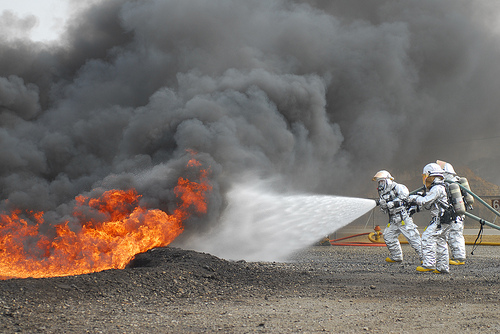As most readers know, employers have very broad responsibilities to provide their employees with a workplace that is “free from recognized hazards.” To meet this Employer’s General Duty, employers must do more than just identify and comply with applicable safety standards issued by the Occupational Safety and Health Administration (OSHA) and its equivalent (I discussed this general provision here). Employers also must take other – unspecified – steps to identify and “recognize” unregulated hazards. One important version of these steps is to watch for non-binding recommendations from OSHA, the National Institute for Occupational Safety and Health (NIOSH), and other credible organizations in industry, government and academia,
Audit, Compliance and Risk Blog
NIOSH Expands Recommendations for Tobacco-Free Workplaces and e-Cigarettes
Posted by Jon Elliott on Tue, Apr 21, 2015
Tags: Corporate Governance, Business & Legal, Employer Best Practices, Health & Safety, OSHA, Employee Rights
OSHA: Winter’s Not Over Yet—Work Safe in Cold Weather
Posted by STP Editorial Team on Mon, Mar 16, 2015
Spring may be just around the corner, but winter isn’t over yet. Those of us who work in comfortable indoor spaces are fortunate that we only experience the cold weather on our way to and from work. However, for the many who work outdoors, the weather presents a daily challenge, especially during winter.
Tags: Corporate Governance, Employer Best Practices, Health & Safety, OSHA, Employee Rights, EHS
Have You Completed Your Hazardous Materials Management Plan?
Posted by Jon Elliott on Wed, Feb 25, 2015
A wide variety of federal, state and even local laws apply environmental, health and safety (EH&S) protection requirements to chemicals. EH&S compliance personnel are accustomed to complying with chemical management requirements imposed by the Environmental Protection Agency (EPA), Occupational Safety and Health Administration (OSHA), and their state equivalents.
Tags: Corporate Governance, Health & Safety, OSHA, California Legislation, Environmental risks, Environmental, EPA, Greenhouse Gas, ghg, Hazcom
The Occupational Safety and Health Administration (OSHA) has updated its recordkeeping rule to expand the list of severe injuries (including amputations) that all employers must report. An increase in good reporting and recordkeeping is a best management practice and an essential part of helping employers ensure and maintain the safest working environments for their employees.
Tags: Corporate Governance, Business & Legal, Employer Best Practices, Health & Safety, OSHA, Employee Rights, Disability benefits
Chemical Safety Board Recommends Better Process Safety Management
Posted by Jon Elliott on Mon, Dec 15, 2014
Within the U.S., most chemical safety requirements are imposed by the Occupational Safety and Health Administration OSHA) and the Environmental Protection Agency (EPA). For example, OSHA (or delegated state agencies) administers a Process Safety Management (PSM) Standard, while EPA (or delegated state agencies) administers the Accidental Release Prevention (ARP) regulation. In addition to these sets of regulators, however, Congress has created a national agency to conduct independent investigations of major chemical accidents, and to issue accident-specific findings and specific or general recommendations for improved chemical handling and regulation. This agency’s formal name is the Chemical Safety and Hazard Investigation Board—which usually refers to itself as the Chemical Safety Board or CSB.
Tags: Corporate Governance, Business & Legal, Health & Safety, OSHA, Environmental risks, Environmental, EPA, Hazcom
Pardon? Did You Say Something About Industrial Noise And Hearing Loss?
Posted by STP Editorial Team on Wed, Nov 12, 2014
Yes, we did. We said that noise, as a by-product of industrial processes, is one of the most pervasive occupational health concerns, contributing to approximately 16% of the disabling hearing loss in adults on a worldwide scale. Ten million people in the U.S. alone have a noise-related hearing loss and twenty-two million workers are exposed to potentially damaging noise each year. In 2007 the National Institute of Occupational Safety and Health (NIOSH) estimated that approximately 23,000 cases of occupational hearing loss were reported as causing hearing impairment and that this alone accounted for 14% of occupational illness that year.
Tags: Corporate Governance, Business & Legal, Employer Best Practices, Health & Safety, OSHA, Employee Rights
In September I blogged about OSHA’s Airborne Contaminant Standard, which sets ambient air limits for over 400 workplace air contaminants to protect employees from exposures to airborne chemical and particulate contaminants in workplace air. In October, OSHA issued an extensive Request for Information (RFI), asking for comments on a variety of approaches to setting these limits in the future. In the RFI, OSHA notes that most exposure limits date from 1971, and so they don’t reflect four decades of advances in understanding of chemical toxicology. OSHA is attempting to build on legal requirements for standard-setting developed by court cases since 1971, and to update—the agency doesn’t say finesse—some of the limitations. The RFI asks over 50 questions, and solicits comments no later than April 8, 2015.
Tags: Corporate Governance, Business & Legal, Health & Safety, OSHA, Environmental risks, Environmental
OSHA: Providing Lockout/Tagout to Protect Workers from Equipment
Posted by Jon Elliott on Wed, Oct 08, 2014
Most Occupational safety and Health Administration (OSHA) electrical safety and machine guarding standards apply to protect employees from electrical and kinetic energy hazards during routine operations. But OSHA also requires protection during equipment servicing and maintenance, lest employees be injured by “unexpected” equipment energization, start up, or release of stored energy. OSHA’s Control of Hazardous Energy Standard—more often called the Lockout/Tagout or “LOTO” Standard after its primary compliance requirements—requires employers to establish and implement safety procedures to control such hazardous energy.
Tags: Corporate Governance, Business & Legal, Employer Best Practices, Health & Safety, OSHA, Employee Rights, Environmental risks, EHS, Hazcom
The Occupational Safety and Health Administration (OSHA) has long required all employers to report work-related accidents that result in three or more deaths or serious injuries (what OSHA calls "catastrophes"). On September 18 OSHA published changes to these requirements that expand employers’ reporting requirements effective January 1, 2015 (I blogged about OSHA’s proposal here).
Tags: Corporate Governance, Business & Legal, Employer Best Practices, Health & Safety, OSHA, Employee Rights, Environmental risks, Environmental, EHS
OSHA regulates workplace air contaminants to protect employees from exposures to airborne chemical and particulate contaminants in workplace air. Generally, employee exposures are limited by permissible exposure limits (PEL) based on a time-weighted average (TWA) over an 8-hour workday. OSHA also allows exposure to some contaminants at greater “excursion limits” for short periods of time, subject to “ceiling values.” Many of these limits are based on voluntary standards developed by the American Conference of Governmental Industrial Hygienists (ACGIH).
Tags: Corporate Governance, Business & Legal, Employer Best Practices, Health & Safety, OSHA, Employee Rights, Environmental risks, Environmental, EHS, Hazcom










